The Experimental Fall Chinook Salmon Fishery in the Clearwater River:
Lessons Learned and Future Opportunities
By Allison Lebeda, Joe DuPont, and Don Whitney
Last fall, an experimental fall Chinook Salmon fishery was provided for the first time in almost 100 years in the Clearwater River above Memorial Bridge. Providing fall Chinook Salmon fishing opportunities upstream of Memorial Bridge has been controversial because of the potential impacts this fishery could have on a popular catch-and-release steelhead fishery that attracts anglers from around the world. While many people are excited about increased fishing opportunities in the Clearwater River, some are concerned the new fishery may negatively impact the experiences of steelhead anglers who often enjoy lower amounts of effort during the catch-and-release season. Ultimately, an experimental fall Chinook Salmon fishery was operated in 2019 to inform a citizen working group called the Clearwater River Fisheries Working Group. This working group has been charged to develop proposals describing seasons and limits for steelhead and fall Chinook Salmon in the Clearwater River that will provide fishing opportunity for fall Chinook Salmon while protecting the integrity of the catch-and-release steelhead season Clearwater Fisheries Working Group.
Now that we have had a chance to analyze the data we collected while the fall Chinook Salmon and steelhead fisheries occurred, we wanted to share what we learned with you. Ultimately, what we hoped to learn from this experimental fishery was as follows:
1) Does angler satisfaction and angler effort differ between the days when only the catch-and-release steelhead season was open and when both the catch-and-release steelhead and fall Chinook Salmon fisheries were open?
2) What were the most important factors that influenced angler satisfaction?
3) Do fall Chinook Salmon anglers fish the same areas on the river that steelhead anglers fish?
The strategy we used to help answer these questions was as follows:
The experimental fall Chinook Salmon fishery opened August 30, 2019 on Thursdays through Sundays until it closed on October 13, 2019. Notably, there were 4 full weeks in September where the experimental fall Chinook Salmon fishery overlapped with the steelhead fishery (see diagram below). We were not able to make comparisons through October 13 because the steelhead fishery in the Clearwater closed after September 29, 2019 due to poor returns. During these 4 weeks in September, Idaho Department of Fish and Game (IDFG) monitored days when only the steelhead fishery was open (Monday through Wednesday) and days when both steelhead and the experimental fall Chinook Salmon fisheries were open (Thursday through Sunday). This strategy allowed us to compare angling satisfaction and effort when only steelhead fishing was open to days when fall Chinook Salmon fishing was also open.
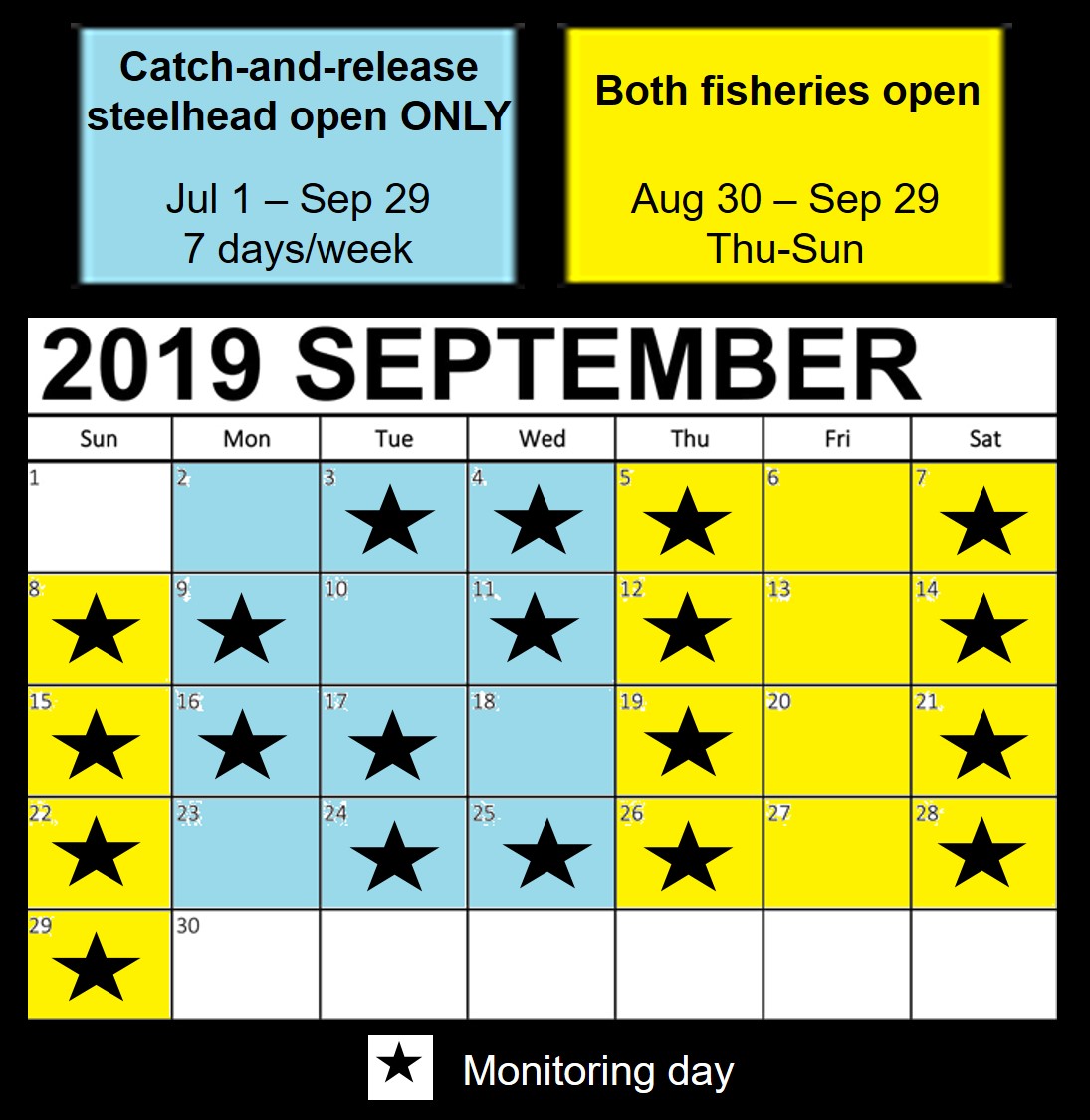
On each monitoring day, IDFG staff recorded GPS locations of all anglers they saw and documented whether they were a non-fly shore angler, fly shore angler, or non-fly boat angler. This occurred from Memorial Bridge upstream to Orofino Bridge (see map below) during the first 4 hours of daylight when the majority of different angler types shared the river. Additionally, IDFG staff interviewed anglers from shore and at boat ramps to ask about their fishing experiences. During interviews, anglers were asked to rate their experience on a scale from 1 to 5 (1=poor, 5=excellent) and to list the top 3 positive or negative factors that influenced their experience.
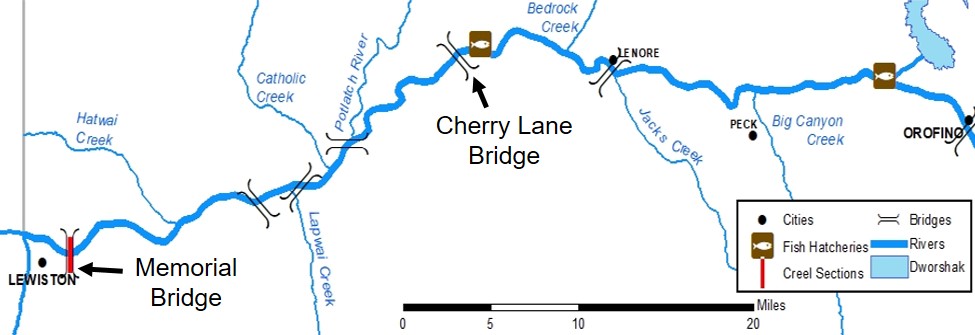
Using the methodology described above, this is what we learned.
During our morning counts when we recorded the location of all shore and boat anglers we saw, we counted 156 shore anglers and 182 boat anglers (based on interviews, on average, there were 2 people in each boat we counted) throughout the month of September. The figure below summarizes this data, and it shows that on average the number of boat anglers and non-fly shore anglers increase when the fall Chinook Salmon fishery was open whereas the number of fly anglers slightly decreased until the weekend.
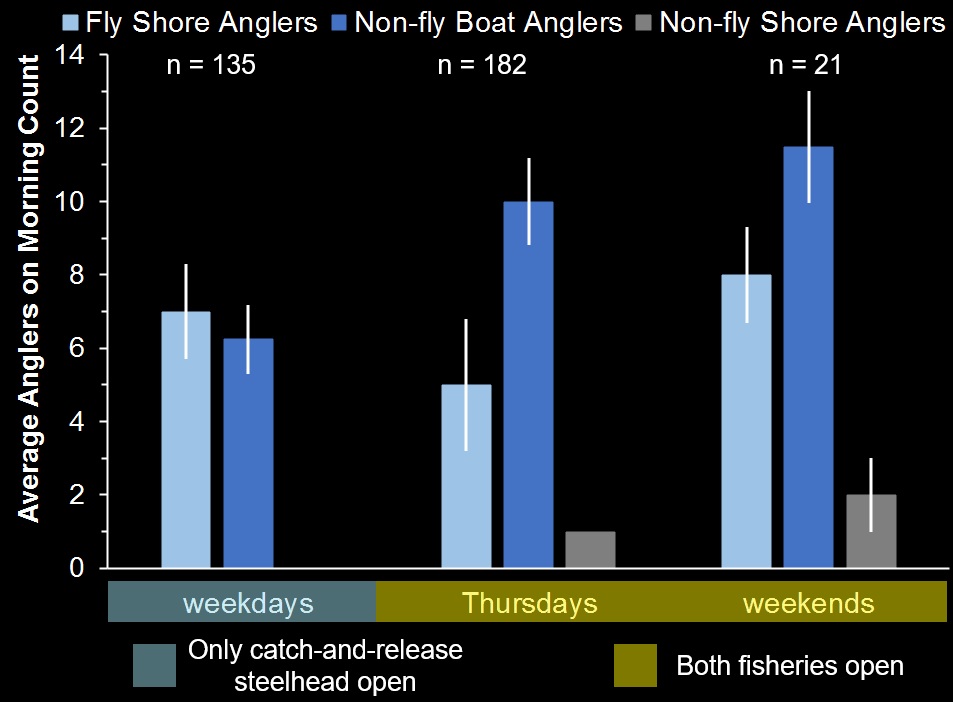
During the 4 weeks in September, we interviewed 157 steelhead anglers, of which 93 were fly anglers and 64 were non-fly anglers (see figure below). We analyzed responses from fly anglers separately from non-fly anglers because previous surveys have shown that fly anglers are more cautious about supporting a fall Chinook Salmon fishery in the Clearwater River. Both fly and non-fly steelhead anglers rated their fishing experience as above average (rating of a 3 or higher), and fly anglers tended to rate their experience better than non-fly anglers. Additionally, angler satisfaction was slightly higher (although not significantly higher) for fly anglers on weekdays when only steelhead fishing was open when compared to weekdays when both fisheries were open.
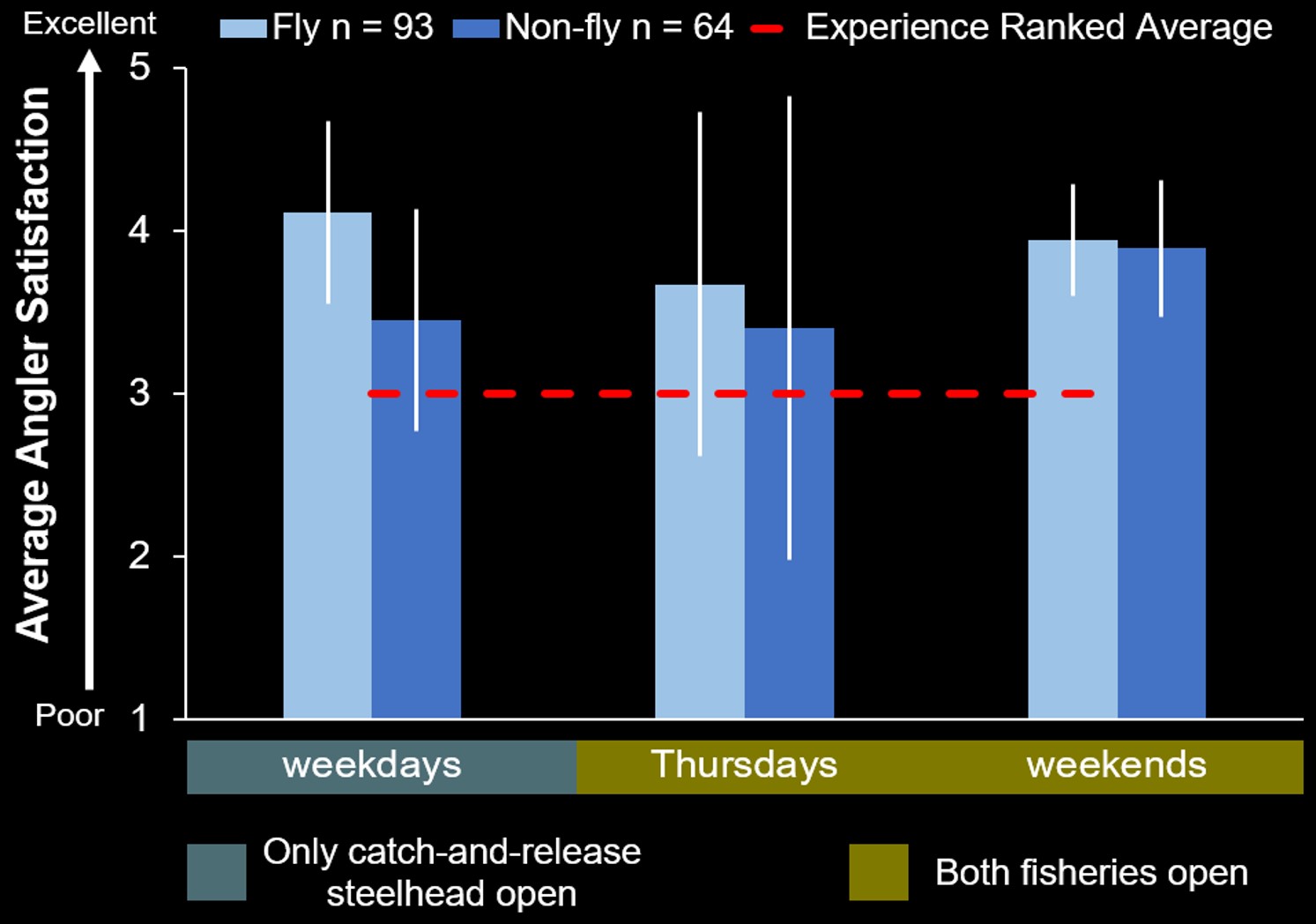
Next, we examined what factors influenced anglers’ fishing experience. The majority of responses (70%) anglers provided as influencing their fishing experience were positive in nature, although the response provided most often (poor fishing) was negative (see figure below). The most important positive influences listed by fly anglers were “it’s good to be out fishing”, “the weather/fishing conditions were good”, and “I enjoy the sport/challenge of fly fishing”. The most important positive influences provided by non-fly anglers were “the weather/fishing conditions were good”, “it’s nice to spend time with friends and family” and “it’s nice to be outside/in nature”. Interestingly, good fishing and not having crowded fishing conditions, while important, were not in the top 3 positive factors influencing either fly or non-fly anglers’ experiences. The most common recorded negative influence (and most common comment overall) given by both fly and non-fly anglers was “poor fishing”. This was not too surprising seeing the steelhead return last year was one of the worst we have seen in years. Despite increases in fishing effort when the fall Chinook Salmon fishery was open, anglers rarely commented that crowding/competition with other anglers or boat traffic was an issue.
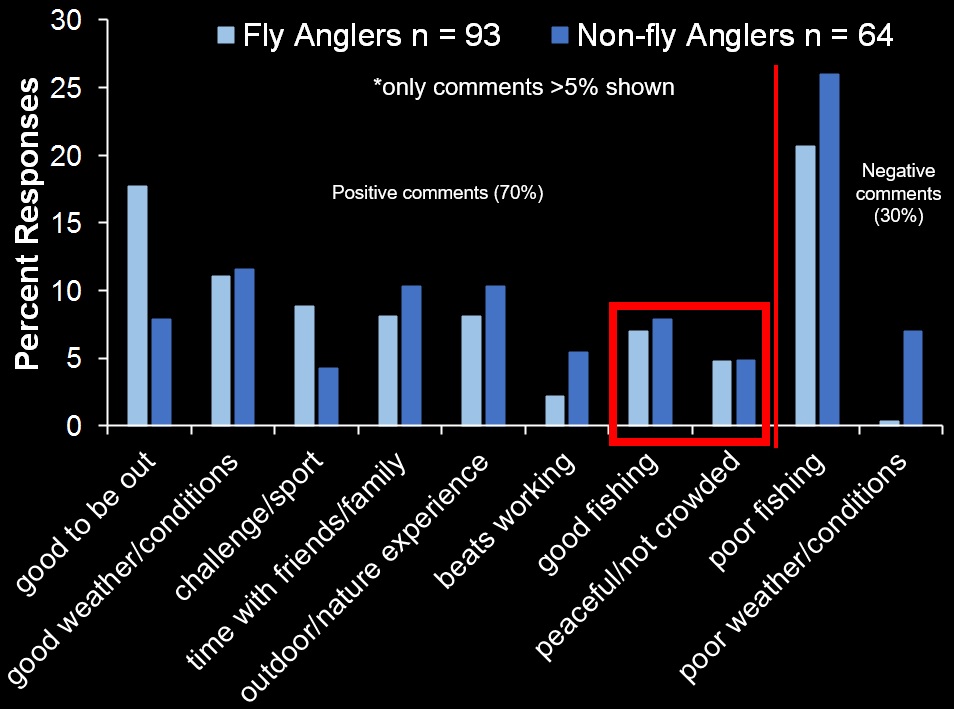
Lastly, we explored whether steelhead and fall Chinook Salmon anglers fished the same areas on the river. If both angler types fish the same locations, it could lead to conflict between angler groups. For this analysis, we focused on the last week in September because that is when the highest numbers of anglers were observed, and as a result, anglers were more likely compete for the same fishing areas. The figures below show where shore anglers and boats anglers were observed fishing. The locations of recognizable landmarks are shown with arrows and labels.
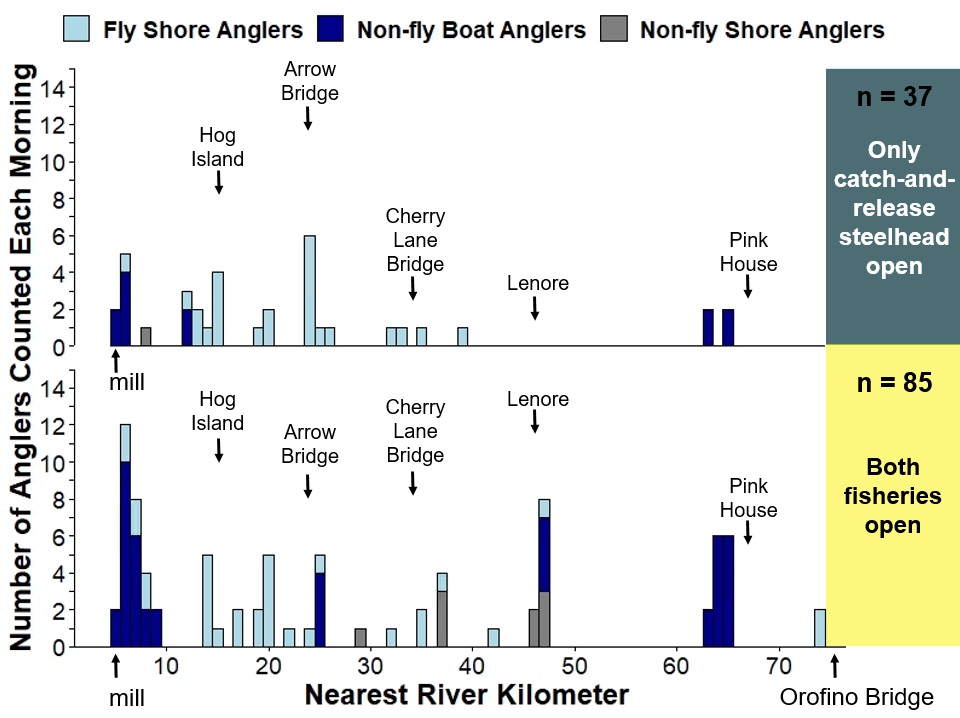
The top graph shows the number of anglers counted at each river kilometer from Memorial Bridge to Orofino Bridge on the monitoring days when only steelhead fishing was open. You will notice in the top graph that fly anglers dominated the steelhead fishery during this period while a few boat anglers congregated near the paper mill and Pink House boat ramp. Only one non-fly shore angler was documented above Memorial Bridge; most non-fly shore anglers fished downstream of Memorial Bridge during this period.
The bottom graph shows the number of anglers and boats counted at each river kilometer from Memorial Bridge to Orofino Bridge on the three monitoring days (Thursday, Saturday, and Sunday) when both fisheries were open. You will notice this bottom graph shows more non-fly shore anglers congregated near Cherry Lane Bridge and Lenore. These non-fly shore anglers were mostly fishing for fall Chinook Salmon. The number of boats counted during this period also increased and was mostly a result of the weekend although we suspect a couple of the boats in the Lenore and Arrow Bridge area were fishing for fall Chinook. In general, except for the area between Arrow Bridge and Lenore, steelhead and fall Chinook Salmon anglers fished different areas on the Clearwater River. In addition, where this overlap occurred, fall Chinook anglers tended to fish deeper water than steelhead anglers.
Based on the finding from the 2019 experimental fall Chinook Salmon fishery, managers concluded that the number of anglers did increase when the fall Chinook Salmon fishery was open and angler satisfaction for steelhead anglers did decline slightly. However, steelhead angler’s level of satisfaction remained above average throughout all days, and rarely did they comment that competition for space or boat traffic negatively influenced their experience. In addition, fall Chinook Salmon anglers didn’t appear to fish the same areas that steelhead anglers fished.
It should be noted that the combination of poor steelhead returns and anglers’ unfamiliarity with the new fall Chinook Salmon fishery in the Clearwater River led to overall low levels of fishing effort which may have biased the results. Therefore, a second experimental season was approved for this fall that could provide further, and perhaps more accurate information to the Clearwater River Fisheries Working Group on how a fall Chinook Salmon fishery may influence steelhead anglers. Similar to last year, IDFG will again use this experimental fishery to learn how both fisheries can merge for the enjoyment of all anglers.

